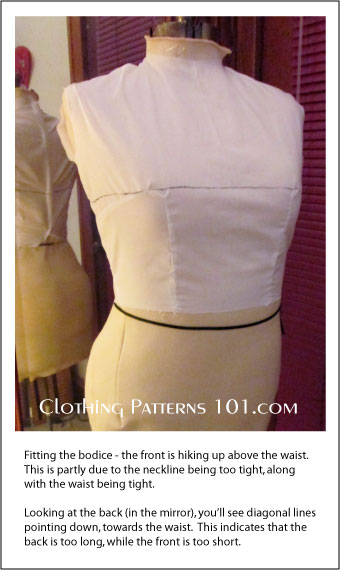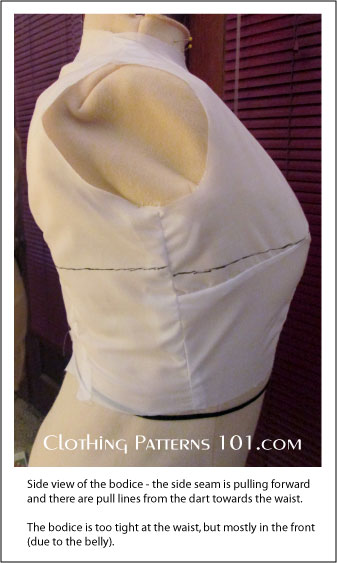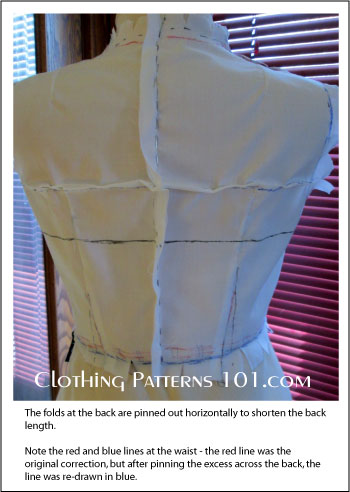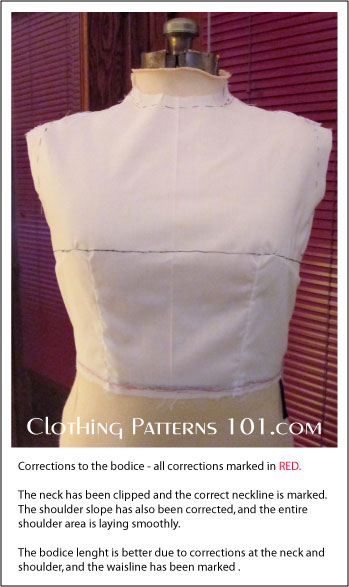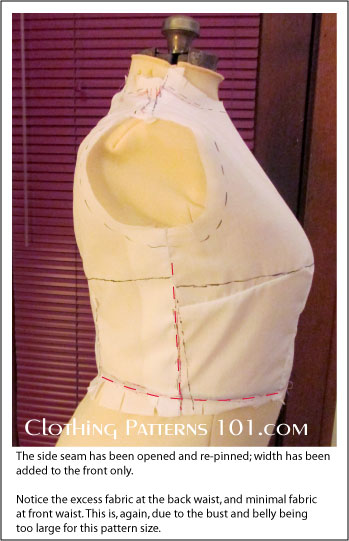- Clothing Patterns 101
- Using the Fitting Pattern
- Fitting the Bodice
How to Fit the Bodice Block Pattern
Fitting the bodice pattern is the first job you’ll tackle in making your personal block. It may seem a bit daunting - but once you have a good-fitting bodice, you’ll never have to worry about it again!
Put the bodice muslin on yourself or the dress form and pin it closed along the marked seamline. Bear in mind that the muslin offers very limited garment ease.
It is intended to fit closely, probably more closely than you are accustomed to wearing your clothes. But the fit should still be reasonably comfortable and you should be able to move freely. If not, you’re finding a fit problem.
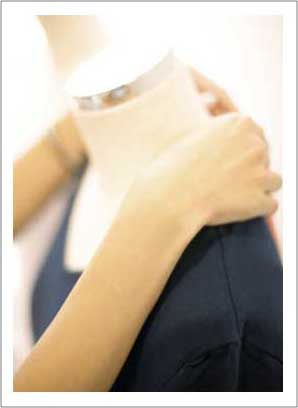
Now, step back and take a good look at how the bodice fits. I’ve always believed that the garment will tell you what it needs. What is the bodice telling you?
Now - Do you feel the need to clip a curve, release a dart, or open a seam to allow more room? Or do you feel you need to pin up excess fullness? You may need to do both, in different areas of the bodice.
These photos show a bodice being fit on my personal dress form (big belly and all!). I am far from a perfect proportion, so there are plenty of fit issues illustrated here.
First, take a look at the marked grainlines, both vertical and horizontal. Are they hanging straight? If vertical lines seem to be hanging at an angle or horizontal lines are curved, that’s an indication of a problem.
Also look for wrinkles or other tell-tale lines that speak of fit problems. If the bodice is tight across the bust, there will be horizontal lines across the apex (fullest part) of the bust; you’ll see the same thing if it’s tight across the back.
If the bodice is baggy or droopy, there may be vertical or diagonal lines showing that the fabric drapes where it shouldn’t.
On my bodice, you’ll see that the front waist does not reach the tape marking the waist on the form. The bodice is quite short in the front (due to the larger bust and belly).
In the mirror, you can see that the back is too long – there is bunching at the waist and fold lines that indicate too much fabric in the back.
Looking at the bodice from the side, you can see that the side seam is pulling forward and there are pull lines below the front dart. These lines are not folds of excess fabric (like in the back), but lines that indicate that the front is too tight and is pulling the side forward.
The good news is, the grainlines are straight!
Go ahead and start pinning or releasing darts and seams as needed. Do this until the bodice hangs evenly, the fabric is smooth, and the fit is close but still comfortable.
When you’ve pinned the bodice pattern in a way that fits and hangs well, MARK YOUR CHANGES (I use a red felt-tipped pen for this). Do this BEFORE you remove the bodice from the form.
Re-sew the bodice using the red lines to make your sewing alterations and re-fit.
Is it better? Have other problems arisen from the changes you made? It happens; just keep making corrections until you’re satisfied with how it looks and fits.
What's the Next Step?
Once you have fit the bodice pattern to your satisfaction, you can set the sleeve (if you made any changes that affect the armhole, like the one above, you’ll need to adjust the underarm seam of the sleeve first).
Then go on to “Fitting the Sleeve”.
Step-by-Step: Making and Fitting Your Block
- Make Clothes that Fit You Perfectly
- Using Fitting Patterns
- A Beginner's Guide to Drafting a Dress Block
- Fitting the Bodice Pattern
- Full Bust Adjustment
- Fitting the Sleeve Pattern
- Fitting the Skirt Pattern
- Making Your Personal Pattern Block
- Making a Women's Blouse Block
- Fitting the Pants - Initial Fitting
- Fitting the Pants - Final Fitting
- A Beginner's Guide to Drafting a Pant Block
- The Importance of Sewing Darts
- Pattern Grading
Need More Help with Fitting Issues?
The examples on this site reflect MY fitting issues and how I resolved them. Your body is likely very different.
But, since this is a site about the mechanics of making patterns and not specifically about fitting, I'm not going to address other fit issues here. And believe me, there are others who can address this issue better than me.
Any of the books listed below will help you achieve good fit. You can use the techniques on any pattern; but why make the same corrections over an over again? Apply the principles to your block, and the fit corrections YOU need will be automatically built in to every pattern you make!
I can recommend any of the following books and an online course to help you achieve good fit, no matter what your size or shape. I own or have used almost all of the books on this list, and have been pleased with how they address fit problems.
Click on the TEXT links below to go to the item in Amazon. As an Amazon Associate I earn from qualifying purchases. This helps to keep this site free for your use. You are free to search Amazon for these or other similar items without using the affiliate links on this page.
- Sewing Pattern Alterations: Fixing Fit Issues - This online course from Udemy is essential for creating clothing with a good fit. There's nothing worse than spending time and money on making a garment, only to find it doesn't fit well! Learn how to fix the pattern BEFORE you cut into your fabric! The course covers necklines, sleeves, skirts and pants.
• Pattern Fitting With Confidence - A very useful book written by the late Nancy Zieman, host of the TV series "Sewing with Nancy". She provides a straightforward, down-to-earth approach to sewing and fitting. Very user-friendly.
• The Complete Photo Guide to Perfect Fitting - I love this book!!! So wonderfully illustrated with photos, using commercial patterns to demonstrate the pattern alterations. It addresses almost any fit problem you might have. So easy to understand and follow!
• Sewing for Plus Sizes - Creating Clothes that Fit and Flatter - A great book for Plus sizes! As a woman gets larger, it's not just the measurements that change - our overall proportions shift, too. This book addresses the different body types and proportions you commonly see in larger women. Truly helpful for larger women.
